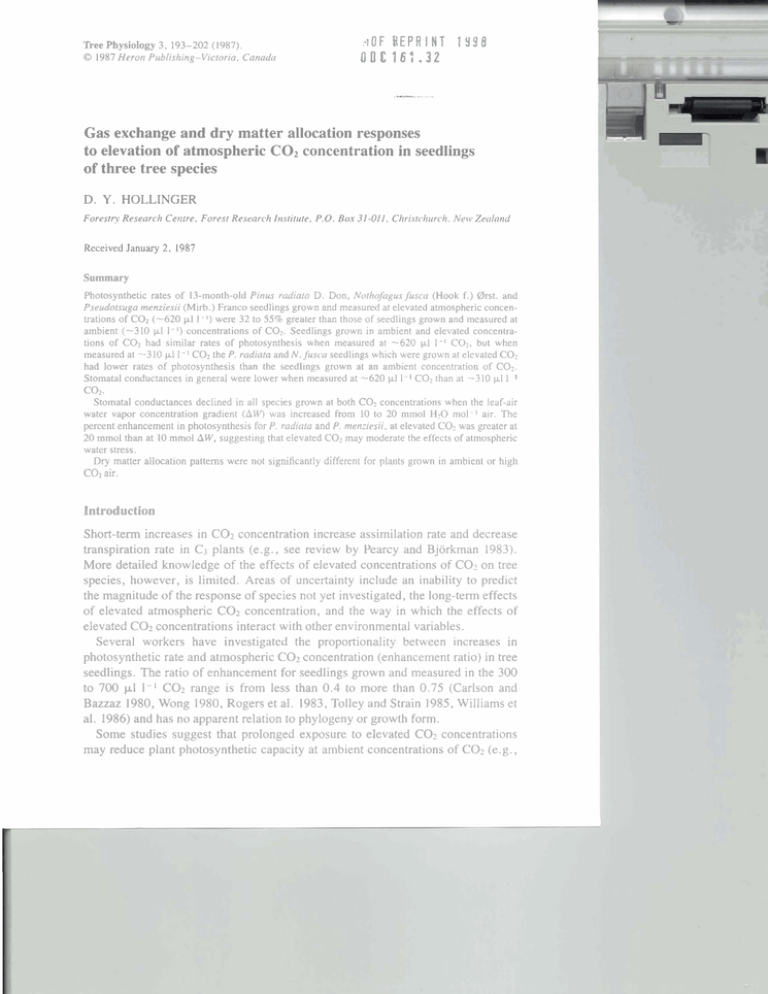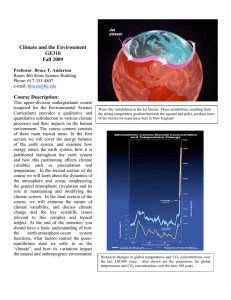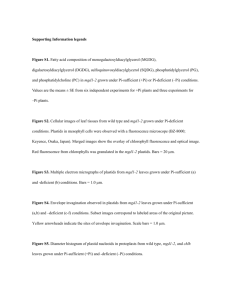R E P R I N T
advertisement

REPRINT 1998 n e e Physiology 3, 193-202 (1987). :tOF 6 1987 Heron Publishing-Vicroria, Canadn 0 0 1 1 6 : .32 Gas exchange and dry matter allocation responses to elevation of atmospheric C 0 2 concentration in seedlings of three tree species D. Y. HOLLINGER Forest~yResearch Cerlrre. Foresr Research Inslitule. P.O. Bo.r 31-011. Chri.rtc.lrurc.h.Neli Zetrl~rnrl Received January 2, 1987 Summary Photosynthetic rates of 13-month-old Pinus rndiarn D. Don, Notf~ofngusfusca (Hook f.) 0rst. and Pseudofsuga menziesii (Mlrb.) Franco seedlings grown and measured at elevated atmospheric concentrations of C 0 2 (-620 pI I -') were 32 to 558 greater than those of seedlings grown and measured at ambient (-310 )11 I-') concentrations of CO?. Seedlings grown in ambient and elevated concentrations of COz had similar rates of photosynthesis when measured at -620 ~1 I-' COz, but when measured at -310 p1 I-' C 0 2the P. rcldiata and N. fusca seedlings which were grown at elevated COz had lower rates of photosynthesis than the seedl~ngsgrown at an ambient concentration of CO?. Stomatal conductances in general were lower when measured at -620 p,l I - COz than at -3 10 )*II coz. Stomatal conductances declined In all species grown at both C 0 2 concentrations when the leaf-air water vapor concentration gradient (AW) was Increased from 10 to 20 mmol H1O mol-I alr. The percent enhancement in photosynthesis for P. radiara and P. merciesii. at elevated C02was greater at 20 mmol than at 10 mmol AW, suggesting that elevated CO1 may moderate the effects of atmospheric water stress. Dry matter allocation patterns were not s~gnificanrlydifferent for plants grown in ambient or high COz air. Introduction Short-term increases in COr concentration increase assimilation rate and decrease transpiration rate in C3 plants (e.g., see review by Rarcy and Bjorkman 1983). More detailed knowledge of the effects of elevated concentrations of CO, on tree species, however, is limited. Areas of uncertainty include an inability to predict the magnitude of the response of species not yet investigated, the long-term effects of elevated atmospheric COz concentration, and the way in which the effects of elevated COr concentrations interact with other environmental variables. Several workers have investigated the proportionality between increases in photosynthetic rate and atmospheric COr concentration (enhancement ratio) in tree seedlings. The ratio of enhancement for seedlings grown and measured in the 300 to 700 pl I - ' COz range is from less than 0.4 to more than 0.75 (Carlson and Bazzaz 1980, Wong 1980, Rogers et a1. 1983, Tolley and Strain 1985, Williams et al. 1986) and has no apparent relation to phylogeny or growth form. Some studies suggest that prolonged exposure to elevated CO, concentrations may reduce plant photosynthetic capacity at ambient concentrations of CO, (e.g., HOLLINGER Frydrych 1976, Wong 1980). Extrapolations of photosynthesis made from measurements on plants grown at ambient concentrations of CO? to plants grown at elevated CO2 must therefore be made with caution. Light, soil water content and soil nutrient status all modify the effects of elevated C02 on seedling gas exchange (Wong 1980, Tolley and Strain 1985, Williams et al. 1986). For example, the greatest relative enhancement of photosynthesis occurs when light intensity is high or the availability of soil water is low. The effects of some environmental factors such as the leaf-air water vapor concentration gradient, AW, on the photosynthetic response to elevated COz concentrations are unknown. In this study, with seedlings of two conifers, Pinus radiatn D. Don and Pseudotsuga menziesii (Mirb.) Franco, and one hardwood species, Nothofagus fusca Hook f.) (drst., I investigated three questions. (1) The relationship between shortand long-term responses to elevated atmospheric CO. concentration. (2) The interaction between COz concentration and leaf-air water vapor concentration difference (AW) in their effects on transpiration and photosynthetic COz assimilation. (3) The influence of atmospheric COz concentration on the production and allocation of dry matter. Methods Nine-month-old, nursery stock of Monterey pine (Pinus radiata), Douglas-fir (Pseudotsuga rnenziesii), and New Zealand red beech (Nothofagus fuscn) were transplanted during the winter into 4-liter containers filled with a 1:1 mixture of sand and vermiculite. The transplanted stock remained outdoors for a further six weeks. Plants of each species were ranked in eight groups of three on the basis of stem diameter. One plant from each group was randomly assigned to each of three sets. One set was harvested immediately for dry weight determinations and the other two sets of eight plants were placed in separate environmentally controlled growth cabinets (Temperzone Ltd., Auckland). Growth conditions for these two groups were identical except for daytime CO? concentration, which was 340 + 20 p1 1 - I for the control plants and 640 ? 30 pl 1-I for the high CO2 treatment. Daylnight temperatures and relative humidities were 20110 "C and 70190% RH, respectively. Photoperiod was 14 hours, with a photosynthetically active photon flux density (PPFD) of 700 + 50 pmol m-' s - I at the top of the canopy provided by mercury halide and tungsten-halogen lamps. Plants were watered with one-half strength Hoagland's solution three to four times per week. Gas exchange measurements and dry weight analyses were made on the plants after 120 days in the cabinets. Chamber CO2 concentration was controlled with a system consisting of an infrared gas analyzer (ADC Mk-3, Analytical Development Company, Hoddesdon, England), gas sampling and switching system, solenoid valves, and controller. This system injected pure COz (underground origin) whenever the carbon dioxide concentration dropped below the set values of 340 and 640 p1 1-I. GAS EXCHANGE, GROWTH AND C02 CONCENTRATION Gas exchange of one to three needles or leaves per plant was measured with an open system similar to that described by Schulze et al. (1982). Measurements were made inside the controlled environment chamber through reach-in ports with an unclimatized (without temperature control), clip-on acrylic plastic cuvette (internal volume approximately 5 ml) instead of the porometer head described by Schulze et al. The CO2 concentration of the airstream was controlled by mixing compressed air from a cylinder with 1% C02 in N2 by means of mass flow controllers (Tylan Corporation, Carson, California, USA), and was humidified by means of a water vapor generator (Model WG-600, Analytical Development Company). Leaf and cuvette airstream temperatures were measured with chromelalumel thermocouples with an electronic reference (Model MCJ, Omega Engineering, Inc., Stamford, Connecticut, USA). Projected leaf areas were measured with a video leaf area meter (Delta-T Devices, Ltd., Cambridge, England) and converted to total leaf area. A flow rate of approximately 300 ml min-I meant that equilibrium conditions were achieved in less than 30 seconds after the cuvette was attached to the foliage. Gas exchange measurements on a single set of leaves or needles from each plant were made on successive days at COz concentrations of approximately 310 and 620 pl I-' CO2, with a leaf-air water vapor concentration difference (AW) of approximately 10 mmol H20 mol-I air. The same foliage was also measured at the concentration of CO2 maintained during growth and with a AW of approximately 20 mmol Hz0 mol-1 air. All measurements were made at 20 + 1 "C with a PPFD of 700-800 pmol m-2 s-I. Six hours before gas exchange measurements, conditions of CO2 concentration and relative humidity in the growth cabinets were adjusted to approximate those to be maintained in the cuvette. Photosynthesis, transpiration and conductance values were calculated on the basis of total leaf area (Cowan 1977). Following the gas exchange measurements, plants were harvested and divided into six components; new leaves or needles (foliage produced while the plants were in the growth cabinets), old leaves or needles, new stems, old stems, roots < 2 mm in diameter, and roots > 2 mm in diameter. The material was dried in a forced draft oven to constant weight at 80 "C. Results of the gas exchange and harvest measurements were analyzed with repeated-measures analysis of variance. Significant differences between growth or measurement conditions were determined by F-tests. Results and discussion Growth and allocation Dry weight of all species in both treatments increased approximately three- to fivefold during the 120-day experiment (Table 1). Dry weights of Pinus radiata and Nothofagus fusca seedlings grown at 640 p.1 I-' CO2 were significantly greater at harvest than those of control plants (Table 1). There was no significant effect of COz concentration during growth on dry weight of Pseudotsuga menziesii perhaps Table 6. Percent change (mean and standard deviation) in foliage photosynthesis (A) and conductance (g) with a step increase in AW from 10 to 20 mmol Hz0 mol-I air. Percent change with a 10 mmol H20mol air increase in AW Norhofagus fusca Pinus radiara Ambient COz Elevated COZ Ambient COZ Pseudotsuga menziesii Elevated C02 (* = Response of plants grown and measured at approximately 620 )11 I - ' COz significantly different (P measured at approximately 310 )11 I-'.) Ambient C02 Elevated C@ < 0.05, r-test) from plants of same species grown and HOLLINGER Table 1. Dry weights of tree seedlings (g per seedlings, mean and standard deviation). Species P. radia~a N. fusca P. menziesii Before treatment 1 1 . 1 (3.3) 1.3 (0.4) 4.5 (1.6) After 120 days growth 330 pl I ' COz 630 p1 I-' COZ 46.4 (13.1) 4.2 ( 1 .O) 18.5 ( 8.1) 59.1 (12.9)" 4.9 ( 1.9)* 19.0 ( 5.4) (* = Mean significantly different from control (330 p.1 I-') value, P < 0.05, repeated measures F-test.) because of the unexpected variability in seedling vigor. The allocation of dry matter within the plant varied among species (Figure 1). Roots made up a significantly higher percentage of total biomass in N. fusca than in P. radiata or P. menziesii. In P. radiata and P. menziesii the allocation to fine roots increased significantly during the 120-day growth period at both control and elevated CO2 concentrations, which suggests that nutrient availability may have been low. The allocation of biomass between root and shoot or between individual structures (e.g., foliage, stems) did not change with CO2 growth concentration for any species (Figure 1). The observed variation in allocation percentages within species was low. There was no significant difference between COr treatments in leaf specific weights (data not shown). Growth at elevated concentrations of COz does not change gross allocation in Acer saccharinum L., Populus deltoides Bartr. ex Marsh., or Platanus occidentalis L. (Carlson and Bazzaz 1980). The evidence for Liquidambar styracij7ua L., however, is conflicting. Sionit et al. (1985) found no difference in root/shoot ratios of seedlings grown for one year at 350, 500, or 650 p1 I-' COz. However, Tolley and Strain (1984) found that root/shoot ratios of Liquidambar seedlings grown for 90 days at 675 and 1000 yl 1 - I were significantly lower than those of seedlings grown at 350 p1 I-', whereas Rogers et al. (1983) found that the root/shoot ratio of Liquidambar grown for about 90 days at 910 p1 I-' CO2 was significantly higher than ratios from plants grown at ambient levels of CO2. In all of these investigations the seedlings were grown in pots. Foliage photosynthesis and conductance Photosynthetic rates and stomata1 conductances both differed significantly among species, the conifers having the highest values (Tables 2 and 4). For each species, photosynthetic rates were significantly higher when measured at 620 p1 I-' CO2 than when measured at 310 p1 1-' C02 (Tables 2 and 3). The enhancement of photosynthesis as a proportion of the increase in concentration of C02 of plants grown and measured at ambient (about 310 p1 I-' CO2) versus -620 ~1 1 - I C02 was about 0.55 for P. radiata, 0.45 for N . fusca, and 0.32 for P. menziesii. These enhancement ratios are similar to those obtained for seedlings of other tree species (e.g., Rogers et al. 1983, Williams et al. 1986) and will likely GAS EXCHANGE, GROWTH AND C o t CONCENTRATION Pinus r a d i a t a 95% C o n f i d e n c e Interval Pseudotsuga menziesii Nothofagus fusca 401- Foliage Stems Fine Roots C o a r s e Roots Figure I. Dry matter allocation In tree seedlings. Elevated CO1 concentrations during growth did not change allocation m any species. vary somewhat depending on nutrient or water availability during growth (Sionit et al. 1980, Wong 1980, Tolley and Strain 1985). The concentration of COz in which the plants were grown had no simple effect on photosynthetic rates (Tables 2 and 3). The ANOVA table (Table 3) shows that. in P. radiata and N. fusca, there was a significant interaction between growth and measurement concentrations of COr on photosynthetic rates. Inspection of Table 2 suggests that growth concentration of C02 had no effect on photosynthesis measured at 620 p1 l-' CO2, but that when measurements were made at 310 p1 1-1 COz, plants grown in elevated concentrations of COz had lower photosynthetic rates than plants grown in ambient concentrations of COz. This decrease in photosynthetic capacity at ambient concentrations of COr in plants grown at elevated concentrations of C02 has been 05served in other species (Hofstra and Hesketh HOLLINGER Table 2. Photosynthetic rate of tree seedlings grown at 340 and 640 p1 I - ] C 0 2 (kmol COz m-* s-I, mean and standard deviat~on)]. Concentration of COz during growth ( d l - '1 I Concentration of COz during measurement (p1 I-') 620 3 10 Pinus radrata 310 620 Nothofagus fusca Measurement temperature = 20 k 1 "C, PPFD = 750 H20mol - air. k 310 620 Pseudoisuga menzresir 50 pmol m-'s-l, AW = 10 * 1 mmol Table 3. Analysis of variance of photosynthetic rates DF Source F Prob. P. radiata Growth C 0 2 Measurement CO, Interaction N . fusca Growth CO, Measurement C 0 2 Interaction P rnenziesii Growth C 0 2 Measurement COz Interaction Table 4. Stomata1 conductances of tree seedlings grown at 340 and 640 p1 I-' CO, (mmol m-Is-I, mean and standard deviat~on)~. Concentration of COz during growth Concentration of CO, during measurement (pl I-') 310 620 Pinus radiata - I 310 620 Nothofagus fusca 310 620 Pseudotsuga menziesir - Measurement conditions same as for Table 2. 1975, Imai and Murata 1978, Wong 1979, 1980, DeLucia et al. 1985). Several mechanisms have been proposed, including feedback inhibition due to starch accumulation (Nafziger and Koller 1976), a reduction in inorganic phosphate concentration in the chloroplasts (Herold 1980), an increase in carbonic anhydrase activity (Chang 1975), or a decrease in ribulose-1,5-bisphosphate carboxylase activity (Wong 1979). The results presented here, as well as those of others (e.g., Wong 1979, 1980, Higginbotham et al. 1985, but not DeLucia et al. 1985), suggest that in some cases there is a compensation for the reduction of photo- GAS EXCHANGE, GROWTH AND C 0 2 CONCENTRATION synthetic capacity of plants grown at elevated CO2 concentrations so that photosynthetic rates at high concentrations of CO2 are similar to those of plants grown at ambient concentrations but measured at high concentrations. Wong speculated that the compensation was effected by an increase in chloroplast photochemical activity of plants grown at elevated COz. A result of this compensation is that shortterm experiments with seedlings grown in ambient air measured at elevated levels of CO2 may accurately reflect the response of the same material grown and measured at elevated concentrations of CO2. The concentration of CO2 during plant growth had no simple effect on stomatal conductance (Tables 4 and 5). However, conductances were generally lower when measured at 620 p.1 1-1 than at 310 p.1 I-' CO2. In Pinus radiata, stomatal conductances of plants grown in ambient concentrations of C 0 2 were similar when measured at 310 or 620 p.1 1 - I CO2. Conductances of P. radiata grown at 640 p1 1-I C02, however, were lower when measured at 620 than when measured at 310 p.1 I-' CO2, which suggests that the sensitivity of the stomata to CO2 increased in plants of this species grown in COz-enriched air. For all species and growth treatments, the mean decrease in conductance with a doubling of the CO2 concentration during measurement was about 14%. As a result of the combined effects of increased photosynthesis and decreased conductances, the water use efficiency (moles CO2 assimilated/moles H20 transpired) of plants grown and measured at elevated CO:! was greater than that of plants grown and measured at ambient concentrations of C02. This increase was about 73% in P. radiata, 63% in N . fusca, and 36% in P. menziesii. Effect of leaf-air water vapor concentration gradient Photosynthetic rates and stomatal conductances decreased significantly in all species and for both CO2 growth treatments when AW was increased from about 10 mmol H20 mol- air to 20 mmol Hz0 mol-' air (Table 6). The response of the conifers was somewhat greater than that of N. fusca. Table 5 . Analysis of variance of conductance. -- Source DF F Prob. P. radiara Growth COz Measurement COz Interaction 1 1 0.83 7.35 1 8.67 0.620 0.016 0.010 N.fusca Growth C02 Measurement C 0 2 Interaction P.menziesii Growth C 0 2 Measurement C 0 2 Interaction GAS EXCHANGE, GROWTH AND COz CONCENTRATION In Pinus radiata and Pseudotsuga menziesii, COz concentration modified the effects of AW. The relative stomatal closure induced by a step change in AW in these species was less at the elevated CO2 concentration than at the ambient CO2 concentration. Carbon dioxide concentration did not alter the effect of AW in Nothofagus fusca. In the conifers, however, C02 concentration apparently modifies the gain of the stomata1 feedforward response to AW. Because there is less relative stomatal closure at an elevated concentrations of COz, the relative enhancement of photosynthesis associated with an increase in COa concentration is greater at a large AW than at a small AW. Elevated concentrations of COz have been shown to ameliorate the effects of soil water stress on growth and photosynthesis in wheat (Gifford 1979, Sionit et al. 1980) and Liquidambar (Tolley and Strain 1984, 1985). The results for Pinus radiata and Pseudotsuga menziesii suggest that for these species, elevated CO2 concentrations may also moderate the effects of atmospheric water stress. Acknowledgments U. Benecke and I. McCracken assisted with the gas exchange measurements and with J. Onvin provided valuable comments on the manuscript. A. Allan and J. Byers provided expert technical support. References Carlson, R.W. and F.A. Bazzaz. 1980. The effects of elevated COz concentrations on growth, photosynthesis, transpiration, and water use efficiency of plants. In Environmental and Climatic Impact of Coal Utilization. Eds. J.J. Singh and A. Deepak. Academic Press, New York. pp 609-622. Chang, C.W. 1975. Carbon dioxide and senescence in cotton plants. Plant Physiol. 55515-519. Cowan, I.R. 1977. Stomata1 behavior and environment. Adv. Bot. Res. 4: 117-228. DeLucia, E.H., T.W. Sasek and B.R. Strain. 1985. Photosynthetic inhibition after long-term exposure to elevated levels of atmospheric carbon dioxide. Photosyn. Res. 7:175-184. Frydrych, J. 1976. Photosynthetic characteristics of cucumber seedlings grown under two levels of carbon dioxide. Photosynthetica 10:335-338. Gifford, R.M. 1979. Growth and yield of COz-enriched wheat under water-limited conditions. Aust. J. Plant Physiol. 6:367-378. Herold, A. 1980. Regulation of photosynthesis by sink activity - the missing link. New Phytol. 86:131-144. Higginbotham, K.O., J.M. Mayo, S. L'Hirondelle and D.K. Krystofiak. 1985. Physiological ecology of lodgepole pine (Pinus conrorra) in an enriched C 0 2 environment. Can. J. For. Res. 15:417-421. Hofstra, G , and J.D. Hesketh. 1975. The effects of temperature and C 0 2 enrichment on photosynthesis in soybean. In Environmental and Biological Control of Photosynthesis. Ed. R. Marcell. Dr. Junk, The Hague. pp 71-80. Imai, K. and Y. Murata. 1978. Effect of carbon dioxide concentration on growth and dry matter production of crop plants. IV After-effects of carbon dioxide-treatments on the apparent photosynthesis, dark respiration and dry matter production. Jap. J. Crop Sci. 47:330-335. Nafziger, E.D. and H.R. Koller. 1976. Influence of leaf starch concentration on C 0 2 assimilation in soybean. Plant Physiol. 57:560-563. Pearcy, R.W. and 0. Bjorkrnan. 1983. Physiological effects. In C 0 2 and Plants. The Response of Plants to Rising Levels of Atmospheric Carbon Dioxide. Ed. E.R. Lemon. AAAS Selected Symposia Series, Westview Press, Boulder, Colorado. pp 65-105. Rogers, H.H., G.E. Bingham, J.D. Cure, J.M. Smith and K.A. Surano. 1983. Responses of selected plant species to elevated carbon dioxide in the field. J. Environ. Qual. 12:569-574. HOLLINGER Schulze, E.-D., A.E. Hall, O.L. Lange and H. Walz. 1982. A portable steady-stage porometer for measuring the carbon dioxide and water vapor exchange of leaves under natural conditions. Oecologia 53:141-145. Sionit, N., H. Hellmers and B.R. Strain. 1980. Growth and yield of wheat under COZenrichment and water stress. Crop Sci. 20:687-690. Sionit, N., B.R. Strain, H. Hellmers, G.H. Riechers and C.H. Jaeger. 1985. Long-tenn atmospheric COz enrichment affects the growth and development of LiqLudambar sfyrac$ua and Pinus raeda seedlings. Can. J. For. Res. 15:468-471. Tolley, L.C. and B.R. Strain. 1984. Effects of C02 enrichment and water stress on growth of Liquidambar styracijlua and Pinus taeda seedlings. Can. J. Bot. 62:2135-2139. Tolley, L.C. and B.R. Strain. 1985. Effects of C 0 2enrichment and water stress on gas exchange of Liquidambar styrac$ua and Pinus taeda seedlings grown under different irradiance levels. Oecologia 65: 166-172. Williams, W.E., K. Garbutt, F.A. Bazzaz and P.M.Vitousek. 1986. The response of plants to elevated C02. IV Two deciduous-forest tree communities. Oecologia 69:454-459. Wong, S.C. 1979. Elevated atmospheric partial pressure of COz and plant growth. I Interactions of nitrogen nutrition and photosynthetic capacity in C, and Cgplants. Oecologia 4468-74. Wong, S.C. 1980. Effects of elevated partial pressure of C02 on rate of C02 assimilation and water use efficiency in plants. In Carbon Dioxide and Climate: Australian Research. Ed. G.J. Perman. Aust. Acad. Sci., Canberra. pp 159-166.



